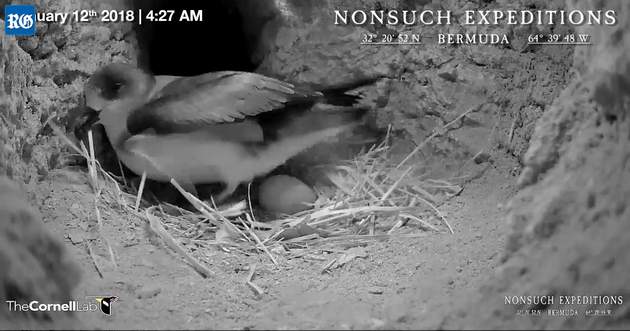Recent News
First Longtail release of the yearFriday, June 01, 2018
In the early morning of Monday, 28th May, Roma Hayward, Animal Care and Quarantine Officer, released our first rehabilitated longtail of the season.
Plein Air Society paints on Trunk Island
Friday, June 01, 2018
After meeting Dr. Ian Walker at a Bermuda Tourism Authority event, Rhona Emmerson was able to arrange for her group of artists - the Plein Air Society - to take a trip out to Trunk Island for a morning of painting on Sunday, 22nd April.
MSA students hold Toad-ally Terrific event
Thursday, May 24, 2018
Pupils from a convent school are helping Bermuda’s struggling toad population.
Video: Bridget The Sea Turtle’s Rehabilitation
Saturday, May 19, 2018
The Bermuda Tourism Authority has released a video highlighting the successful rehabilitation of a sea turtle named ‘Bridget’, with the video also providing tips on how to help if you find an injured turtle.
Endangered predators may lead to erosion of reefs
Thursday, May 17, 2018
Major marine predators including groupers and snappers are endangered, a scientist has warned.
About
GovernanceAbout Us
Newsletter
Latest News
Gift & Bookstore
Contact
General Inquiries
info@bzs.bm
Latest News
All the latest updates and news from the Bermuda Aquarium, Museum, and Zoo, one of Bermuda's leading visitor attractions!
Owain Johnston-Barnes
Published Jan 15, 2018 at 8:00 am (Updated Jan 15, 2018 at 12:20 am)

This year’s cahow breeding season could be a record breaker, experts predicted yesterday.
Two thirds of the 125 known breeding pairs were nursing eggs by Friday.
And viewers of the CahowCam — a livestream of a nest on breeding site Nonsuch Island — were able to watch one of the endangered birds lay its single egg early yesterday morning.
Jean-Pierre Rouja, team leader of conservation group Nonsuch Expeditions, said the egg was laid at about 4.30am and marked the start of the sixth CahowCam season.
Mr Rouja added that the Bermuda team had signed off at 3am, but their partners from US-based Cornell Lab of Ornithology, who are in Hawaii to install a similar camera to track albatrosses, tweeted the event and alerted Bermuda.
Mr Rouja said that last year, with the support of Cornell, the CahowCam reached 600,000 international viewers who watched a total of 8.5 million minutes of footage.
He added: “As we expand the project, including new ways for our viewers and students to engage, we expect to greatly exceed those numbers this season.”
The same pair of cahows has used the filmed nest since 2009.
Jeremy Maderios, government chief conservation officer, said the pair’s egg last year took 51 days to hatch. Male and female birds take turns to care for the egg.
Mr Madeiros said: “After a record-breaking nesting season last year with 61 chicks fledging out to sea, we seem to be on track for breaking even more records this year.”
The majority of incubating adult cahows he had examined were heavier than normal, with some male birds approaching 500 grams.
Mr Madeiros said that suggested the birds had found good feeding conditions north of the Gulf Stream over the last month.
To watch the livestream, visit Nonsuchisland.com.
Anyone interested in updates on the cahows can also sign up for the Nonsuch Expedition Newsletter and select the CahowCam alert option.


